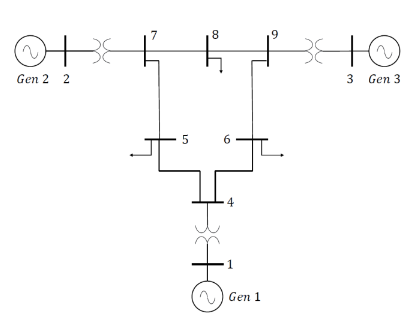Assessment of Transient Stability Indicators with the Integration of Wind Power: a Simultaneous Approach
DOI:
https://doi.org/10.22517/23447214.25259Keywords:
Differential algebraic equations, power system dynamics, power system stability, renewable energy sources, wind power grid integration.Abstract
The energy transition relies on the integration of non-conventional renewable energy sources. These disruptive technological developments alter the functioning and operation of the electric power system. This paper examines the impacts of wind power on transient stability indicators of the power system,
using an implicit formulation and the nine-bus test system. The research findings indicate that transient stability indicators are sensitive to the location and duration of faults. Furthermore, there is an observed trend of increasing maximum rotor speed deviation and oscillation duration, indicating reduced stability margins.
Downloads
References
[1] V. Akhmatov, “Analysis of dynamic behaviour of electric power systems
with large amount of wind power,” Doctoral Thesis, Universidad T´ecnica de Dinamarca, Lyngby, 2003.
[2] J. G. Slootweg, “Wind power: Modelling and impact on power system dynamics,” Doctoral Thesis, Delft University of Technology, Delft, 2003.
[3] Y. Coughlan, “Wind turbine modelling for power system stability
analysis – a system operator perspective,” IEEE Transactions on Power Systems, vol. 22, pp. 929–936, 2007.
[4] M. Vittal, E. O’Malley and A. Keane, “Rotor angle stability with high
penetrations of wind generation,” IEEE Transactions on Power Systems, vol. 27, pp. 353–362, 2012.
[5] A. Agarala and et al., “Transient stability analysis of a multimachine
power system integrated with renewables,” Energies, vol. 15, no. 13, 2022. [Online]. Available: https://www.mdpi.com/1996- 1073/15/13/4824
[6] D. Trudnowski, “Fixed-speed wind-generator and wind- park modeling for transient stability studies,” IEEE Transactions on Power Systems, vol. 19, pp. 1911–1917, 2004.
[7] M. Rahimi and M. Parniani, “Dynamic behavior and transient stability analysis of fixed speed wind turbines,” Renewable Energy, vol. 34, pp. 2613–2624, 2009.
[8] M. Reza, “Stability analysis of transmission system with high penetration
of distributed generation,” Doctoral Thesis, Delft University of Technology, Delft, 2006.
[9] M. Zapata Ceballos, “Estabilidad de peque˜na se˜nal en sistemas de energ´ıa el´ectrica con alta penetraci´on de generaci´on renovable,” Master’s thesis, UNAL Medell´ın, 2020.
[10] J. Chow and K. Cheung, “A toolbox for power system dynamics and
control engineering education and research,” IEEE Transactions on
Power Systems, vol. 7, no. 4, pp. 1559–1564, 1992.
[11] F. Milano, “An open source power system analysis toolbox,” IEEE
Transactions on Power Systems, vol. 20, no. 3, pp. 1199–1206, 2005.
[12] S. Cole and R. Belmans, “Matdyn, a new matlab-based toolbox for
power system dynamic simulation,” IEEE Transactions on Power Systems,
vol. 26, no. 3, pp. 1129–1136, 2011.
[13] I. Abdulrahman, “Matlab-based programs for power system dynamic
analysis,” IEEE Open Access Journal of Power and Energy, vol. 7, pp.
–69, 2020.
[14] P. Aristidou, D. Fabozzi, and T. Van Cutsem, “Dynamic simulation of large-scale power systems using a parallel schur-complement-based decomposition method,” IEEE Transactions on Parallel and Distributed Systems, vol. 25, no. 10, pp. 2561–2570, 2014.
[15] F. Milano, “Semi-implicit formulation of differential-algebraic equations
for transient stability analysis,” IEEE Transactions on Power Systems, vol. 31, no. 6, pp. 4534–4543, 2016.
[16] C. Wang, K. Yuan, P. Li, B. Jiao, and G. Song, “A projective integration method for transient stability assessment of power systems with a high penetration of distributed generation,” IEEE Transactions on Smart Grid, vol. 9, no. 1, pp. 386–395, 2018.
[17] J. Pitteloud, “Wind energy international. obtenido de global wind
installations,” p. 1, 2020.
[18] IEC61400-27-1, “Wind energy generation systems - part 27-1: Electrical
simulation models - generic models,” p. 100, 2020.
[19] J. Fortmann, Modeling of Wind Turbines with Doubly Fed Generator
System, 1st ed. Duisburg: Springer Vieweg, 2015.
[20] A. D. Hansen, “Dynamic wind turbine models in power system simulation
tool digsilent,” Technical University of Denmark, Riso National
Laboratory, Tech. Rep., 2007.
[21] N. Hatziargyriou and et al., “Definition and classification of power system stability – revisited & extended,” IEEE Transactions on Power Systems, vol. 36, no. 4, pp. 3271–3281, 2021.
[22] K. R. Padiyar, Power System Dynamics: Stability and Control, 1st ed. Hyderabad: BS Publicaciones, 2008.
[23] F. Milano, Power System Modelling and Scripting, 1st ed. La Mancha:
Springer, 2010.
[24] J. Sosapanta Salas, “Simulaci´on de la influencia de la generaci´on de
energ´ıa e´olica en la estabilidad transitoria,” Master’s thesis, UNAL,

Downloads
-
Vistas(Views): 421
- PDF (Español (España)) Descargas(Downloads): 253
- HTML (Español (España)) Descargas(Downloads): 10
Published
How to Cite
Issue
Section
License
Copyright (c) 2024 Scientia et Technica

This work is licensed under a Creative Commons Attribution-NonCommercial-ShareAlike 4.0 International License.
Copyrights
The journal is free open access. The papers are published under the Creative Commons Attribution / Attribution-NonCommercial-NoDerivatives 4.0 International - CC BY-NC-ND 4.0 license. For this reason, the author or authors of a manuscript accepted for publication will yield all the economic rights to the Universidad Tecnológica of Pereira free of charge, taking into account the following:
In the event that the submitted manuscript is accepted for publication, the authors must grant permission to the journal, in unlimited time, to reproduce, to edit, distribute, exhibit and publish anywhere, either by means printed, electronic, databases, repositories, optical discs, Internet or any other required medium. In all cases, the journal preserves the obligation to respect, the moral rights of the authors, contained in article 30 of Law 23 of 1982 of the Government Colombian.
The transferors using ASSIGNMENT OF PATRIMONIAL RIGHTS letter declare that all the material that is part of the article is entirely free of copyright. Therefore, the authors are responsible for any litigation or related claim to intellectual property rights. They exonerate of all responsibility to the Universidad Tecnológica of Pereira (publishing entity) and the Scientia et Technica journal. Likewise, the authors accept that the work presented will be distributed in free open access, safeguarding copyright under the Creative Commons Attribution / Recognition-NonCommercial-NoDerivatives 4.0 International - https://creativecommons.org/licenses/by-nc-nd/4.0/deed.es license.


